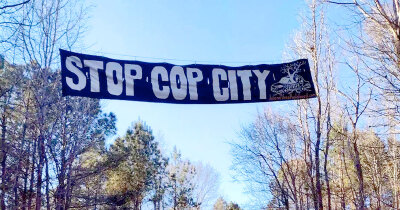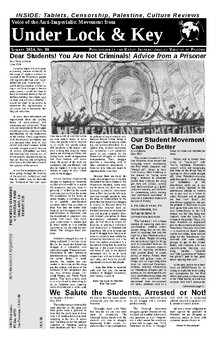
The Struggle Against Cop City in Atlanta

Since 2021, the city of Atlanta in conjunction with its police force and local developers and contractors, has been trying to bulldoze a significant part of the remaining forest in the city and construct an urban warfare training center for police officers. The forest, which formerly contained a slave labor camp and then a state farm ran on prisoner labor, has been the site of occupations, sabotage of construction equipment, protests and raids by the police. Recently, the cops murdered an activist staying in the encampment defending the forest, while revolts in downtown Atlanta and confrontations with police at the site of the forest have resulted in arrests and terrorism charges for dozens of activists. The movement has racked up several victories already, including delaying the construction of the training center by several months and driving several contractors off the project entirely. But the struggle continues. At press time, the forest faces clear-cutting for the initial stages of construction.
Background
Atlanta is a rapidly and brutally gentrifying city, with a nominally Black elected leadership but a housing and economic policy that has displaced thousands of lower income New Afrikan residents. Cops have been used to harass New Afrikan tenants out of public housing to facilitate redevelopment, rent has spiked well above the already bloated national average, and the arrival of movie production companies (facilitated by tax breaks and other favors) has been a major motor of gentrification across the city.(1) The elected leadership of the city is in a bind – they have to deliver economic growth and good jobs, and get re-elected by appearing to stand against police brutality and white supremacy, but are constrained by their own commitment to capitalism and inability to confront the real power structure of the city, which, as we will see soon, is mostly unelected.
Like most Amerikan cities, Atlanta saw a weeks-long uprising against the police following the murder of George Floyd in 2020. In Atlanta, also like other Amerikan cities, local cases of police brutality added extra impetus to the protesters and their demands. The murder of Rayshard Brooks in June of 2020 led to a revolt that burned down the Wendys he’d been killed at(2), the resignation of hundreds of police officers and even the trashing of the offices of the state police. Local lumpen organizations saw a temporary truce and occupied the Wendys site with arms against rumors of white militas seeking to march near the site of Rayshard Brooks’ death. In the wake of these and similar events police and correctional forces nationwide are facing difficulties filling their ranks and reeling from their abject failure to contain the disturbances of 2020, when over sixty thousand (3) National Guard troops had to be called out to back them up. The need for Cop City is itself a sign of weakness, paranoia and poor morale of the police force.
The Campaign in the City Council
In 2021, after the rebellion, the Atlanta City Council met in secret to arrange two land deals in the South Forest, the largest expanse of forest remaining in the Metro Atlanta area. One was to give a movie studio CEO, Ryan Milsap, a swathe of public land to bulldoze and build a large movie production studio on. A second was to give another large chunk of land to the Atlanta Police Foundation, a private nonprofit that gathers money from some of the largest businesses in the region and funds policing initiatives. The APF was to construct a mock city out of concrete, similar to U.S. Military urban warfare training sites, to prepare police to prevent another 2020 from happening. (4)
The Atlanta Police Foundation (APF) is interesting all on its own. It’s entirely private, with unclear finances and no accountability to the public. It’s staffed by former national security officers, real estate investors and retired police; and it has enacted several large-scale programs around the city by itself such as building a center for a massive surveillance network across the entire city which allows footage from thousands of cameras the foundation has installed to be reviewed at one location. The APF has also built up a house renovation program that buys cheap real estate in New Afrikan neighborhoods, remodels it and gives it to police recruits to live in. All of this is done with money donated by corporations ranging from Coca Cola (who did drop out of the Foundation after pressure from activists) to Norfolk Southern. To repeat: large capitalist firms are directly funding, with no public oversight, the extension of massive surveillance networks, police colonization of New Afrikan ghettos, and the construction of a training center intended to make cops more proficient at urban warfare.
The APF is best understood not as a slush fund or a shady organization behind the scenes, but as a de facto shadow government that actually runs the city on behalf of a mostly white bourgeoisie.(5)
Activists uncovered the land deals and organized protests and a campaign to persuade the city council to not approve the projects. After months of rallies, lobbying and canvassing, the Atlanta City Council voted in late 2021 to allow the project to proceed. This outcome, which many of the activists involved in the campaign predicted, marked the first defeat for Stop Cop City. The coalition that managed this campaign, DARC (Defund Atlanta Police Department, Refund Communities) dissolved among accusations that the local chapter of the Democratic Socialists of America (DSA) had tried to take over the campaign and use it (and its failure which they banked on) as a recruiting tool. The DSA’s plan was to allow the campaign to fail instead of criticizing it openly, with the hope that its failure would radicalize people into their organization. Commenting on this, a local communist wrote “the notion that working class Atlantans, people who live their entire lives in the trenches of the city’s class war, require a civics lesson to be radicalized is self-evidently chauvinistic.” (6)
The Campaign in the Weelaunee Forest
Parallel to the campaign against the city council and continuing after it had been defeated, a growing and mostly anonymous group of people calling themselves “forest defenders” were ramping up their activity. Some engaged in tree-sits in the forest, others established gardens or engaged in mutual aid projects and free concerts, and others routinely sabotaged construction and surveying equipment preparing the forest for the project.(7)
At one point members of the Muscogee (Creek) tribe from Oklahoma, who lived in the South Forest before being expelled during the 1820’s, returned to the forest, conducted a stomp dance ceremony and shared the forest’s pre-colonial name: Weelaunee.
Several times, crews hired by Ryan Milsap to start demolishing the forest ahead of official permitting were driven out after direct confrontation by forest defenders. Outside the forest, protests against contractors, politicians and business-people involved in the project routinely escalated to vandalism and provoked repression from the police. In one case, a protest in East Atlanta Village was attacked by cops as it was ending, but the heavy-handed tactics of the police resulted in all 17 arrests being dismissed and thousands in restitution paid to those targeted. One of the general contractors of the project, Reeves + Young, dropped out after another direct protest at their officers and after several of their vehicles were sabotaged in the forest. It should be noted that not all interactions between construction workers and the forest defenders were hostile – when crews from the local power company showed up to do maintenance on a line in the forest, they worked around a garden that forest defenders had planted instead of destroying it.
Throughout late 2021 and 2022 this back and forth continued, with coordinated Weeks of Action bringing hundreds of people into the forest and a fluctuating smaller body of activists building and defending the forest in the interim.
Raids and the Murder of Tortuguita
Different police agencies routinely entered the forest and raided it repeatedly. Last May, following a Week of Action, cops came into the forest and smashed up a lot of protest infrastructure that was on the ground. Activists retreated to the trees, continued confronting work crews and burning equipment that was left unguarded at night. A statement issued after one of these incidents read “if you build it we will burn it.” In December of last year another raid resulted in the destruction of more shelters and 6 people were arrested and charged with ‘domestic terrorism.’
On 18 January 2023, a final raid into the forest by officers from the Georgia State Highway Patrol and numerous other police agencies attacked the forest with guns drawn. During the raid a forest defender sitting under a tarp refused orders to get up and leave, and the cops shot em several times at close range, claiming self defense. Eir name was Manuel Paez Teran (nicknamed Tortuguita or Tort), an indigenous anarchist from Venezuela, and ey’d been living in the forest for almost a year helping to coordinate its supply and defense. The cop story, that Tort had fired first from under the tarp and wounded an officer, began to unravel quickly. On body camera footage released weeks later an officer can be heard saying ‘you fucked your own officer up?’ after the shots, implying that the officer who was wounded was shot by his own people. Tort’s autopsy showed bullet wounds through the palms of eir hands, a story more consistent with an encounter killing than a firefight.(8)
Today
The movement is mostly evicted from the forest for now, and initial tree clearing has begun. The murder of Tortuguita, however, has dramatically raised the temperature of the struggle. The City council has already started walking back some of their plans for Cop City, and support for the movement and criticism of Mayor Dickens for being involved in it, has swelled. It’s also important to remember that without the resistance the whole forest would be gone and Cop City would be half-built already.
For Rayshard Brooks, for Tortuguita, and for victims of poverty and police violence in Atlanta whose names we know and those we don’t, we say Stop Cop City.
NOTES:
(1) Cde. KM Cascia “The White Left is Building Cop City” March 2, 2023.
(2) Greyhound, “On the Tragic Death of Secoriea Turner” July 2020.
(3) Alexandra Sternlicht, “Over 4,400 Arrests, 62,000 National Guard Troops Deployed: George Floyd Protests By The Numbers”.
(4) Crimethinc, “The City in the Forest: Reinventing Resistance for an Age of Climate Crisis and Police Militarization” Crimethinc, April 11, 2022. Background for the struggle aginst Cop City comes from this zine unless otherwise noted.
(5) Cascia, “The White Left Is Building Cop City”
(6) Ibid.
(7) Crimethinc, “The Forest in the City: Two Years of Forest Defense in Atlanta, Georgia” February 22, 2023. All info in this section comes from this zine unless otherwise noted.
(8) Alex Binder, “Manuel ‘Tortuguita’ Terán’s Independent Autopsy Report Released at Press Conference” March 13, 2023.
Related Articles:








